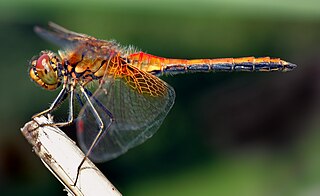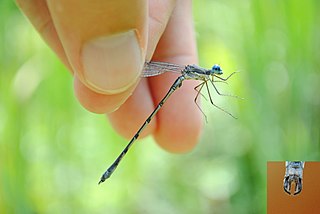Related Research Articles

Odonata is an order of flying insects that includes the dragonflies and damselflies. Members of the group first appeared during the Triassic, though members of their total group, Odonatoptera, first appeared in Late Carboniferous.

A dragonfly is a flying insect belonging to the infraorder Anisoptera below the order Odonata. About 3,000 extant species of true dragonfly are known. Most are tropical, with fewer species in temperate regions. Loss of wetland habitat threatens dragonfly populations around the world. Adult dragonflies are characterized by a pair of large, multifaceted compound eyes, two pairs of strong, transparent wings, sometimes with coloured patches, and an elongated body. Many dragonflies have brilliant iridescent or metallic colours produced by structural colouration, making them conspicuous in flight. An adult dragonfly's compound eyes have nearly 24,000 ommatidia each.

Damselflies are flying insects of the suborder Zygoptera in the order Odonata. They are similar to dragonflies, which constitute the other odonatan suborder, Anisoptera, but are smaller and have slimmer bodies. Most species fold the wings along the body when at rest, unlike dragonflies which hold the wings flat and away from the body. An ancient group, damselflies have existed since at least the Lower Permian, and are found on every continent except Antarctica.

The green darner or common green darner, after its resemblance to a darning needle, is a species of dragonfly in the family Aeshnidae. One of the most common and abundant species throughout North America, it also ranges south to Panama. It is well known for its great migration distance from the northern United States south into Texas and Mexico. It also occurs in the Caribbean, Tahiti, and Asia from Japan to mainland China. It is the official insect for the state of Washington in the United States.

Somatochlora, or the striped emeralds, is a genus of dragonflies in the family Corduliidae with 42 described species found across the Northern Hemisphere.

Lestes is a genus of damselfly in the family Lestidae. The family hold their wings at about 45 degrees to the body when resting. This distinguishes them from most other species of damselflies which hold the wings along, and parallel to, the body when at rest.

The white-faced darter or small whiteface is a dragonfly belonging to the genus Leucorrhinia in the family Libellulidae, characterised by red and black markings and a distinctive white patch on the head. It is found in wetlands and peat bogs from northern Europe eastwards to Siberia, and the adults are active from around April till September, which is known as the "flight period". It breeds in acidic bodies of water, laying its eggs in clumps of sphagnum moss that provide a safe habitat for larval development. The larvae are particularly vulnerable to predation by fish, and so are usually found in lakes where fish are not present. L. dubia is listed as a species of least concern (LC) by the IUCN Red List, however, it is potentially threatened by habitat destruction, pollution, and climate change.
Sir Norman Winfrid Moore, 3rd Baronet was a British conservationist and author who worked extensively on studies of dragonflies and their habitats and was one of the first people to observe and warn of the adverse effects of DDT and other organochlorine pesticides on wildlife. The Independent described him in his obituary as one of the most influential figures in nature conservation in the second half of the 20th century.

The sweetflag spreadwing is a species of damselfly in the family Lestidae, the spreadwings. It is native to North America, especially eastern parts of Canada and the United States.

Lestes dryas is a species of damselfly in the family Lestidae, the spreadwings. Its common names include emerald spreadwing, scarce emerald damselfly and robust spreadwing. An alternate name in Ireland is the turlough spreadwing.
Stephen J. Brooks FRES is a British entomologist working at the Natural History Museum, London.
Odonata are insects with an incomplete metamorphosis (hemimetabolous). The aquatic larva or nymph hatches from an egg, and develops through eight to seventeen instars before leaving the water and emerging as the winged adult or imago.

Coryphaeschna viriditas, the mangrove darner, is a species of darner in the family Aeshnidae. It is found in the Caribbean, Central America, North America, and South America.

Aeshna subarctica, the subarctic darner, is a species of darner in the family Aeshnidae. It is found in Europe and Northern Asia and North America.

Nehalennia integricollis, the southern sprite, is a species of narrow-winged damselfly in the family Coenagrionidae. It is found in North America.
References
- ↑ Dunn, Rod; Budworth, Dave (2005). Dragonflies in Derbyshire. Derbyshire & Nottinghamshire Entomological Society. p. 4. ISBN 0-9511141-3-1.
- 1 2 3 4 "British Dragonfly Society" . Retrieved 13 March 2013.
- ↑ "British Dragonfly Society, registered charity no. 800196". Charity Commission for England and Wales.